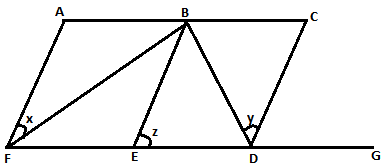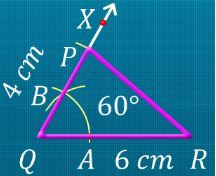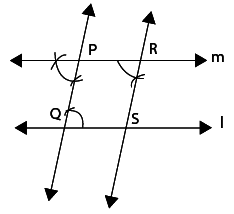7th Grade > Mathematics
PRACTICAL GEOMETRY MCQs
Total Questions : 105
| Page 2 of 11 pages
:
Construction: 2 Marks
Steps: 2 Marks

To construct: A lineparallel to given line by using ruler and compass.
Steps of construction:
1) Draw a line segment AB and take a point C outside AB.
2) Take any point D on AB and join C to D.
3) With D as the centre and taking convenient radius, draw an arc cutting AB at E and CD at F.
4) With C as the centre and same radius as in step 3, draw an arc GH cutting CD at I.
5) With the same arc EF, draw the equal arc cutting GH at J.
6) Join JC to draw a line l.
:
Steps: 1 Mark
Construction: 1 Mark

Steps of construction:
(i) Draw a line l.
(ii) Take a point M on it.
(iii) Draw an angle of 90∘ at M with l which is perpendicular to l at M.
(iv) With M as centre and radius 5.2 cm, draw an arc which intersects the above perpendicular at point P. MP is the required perpendicular.
(v) At P, draw an angle of 90∘ with PM andmake a line q.
Line q is the required line parallel to line l.
:
Each part: 2 Marks
(a) Steps of construction:
Draw ¯¯¯¯¯¯¯¯PQ=3.5cm
With P as the centre, draw an arc with the radius equal to 4.5 cm.
With Q as the centre, draw another arc with radius 5.5 cm to cut the previous arc at R.
Join R to P and Q.
PQR is the required triangle.

Thus, we see that if three sides of a triangle are given and the sum of any two sides is always more than the third side, then a triangle can be constructed. This is known as SSS criterion for construction of triangles.
(b) Steps of construction:
Step 1: Draw a line segment QR = 6 cm.
Step 2: Construct an angle of 60∘ at point Q.
Step 3: Draw an arc on the ray QX with Q as the centre and the radius equal to 4 cm.
Step 4: Name the point where the arc cuts the ray QX, as P.
Step 5: Join points P and R.
PQR is the required triangle.

:
Steps: 2 Marks
Construction: 2 Marks
To construct: A pair of parallel lines intersecting other parts of parallel lines.
Steps of construction:

Draw a line l and take a point P outside l.
Take point Q on line l and join PQ.
Make equal angle at point P such that ∠Q=∠P.
Extend line at P to get line m.
Similarly, taking a point R on line m, at point R, draw angles such that ∠P=∠R.
The extended line at R which intersects at S on line l, Draw line RS. Thus, we get a parallelogram PQRS.
:
Construction: 2 Marks
Steps: 2 Marks
Draw ¯¯¯¯¯¯¯¯PQ=3.5cm
Construct ∠XPQ=120∘ with your compass.
With P as centre, draw an arc with radius equal to 3 cm that intersects ¯¯¯¯¯¯¯¯¯XP at point R.
Join ¯¯¯¯¯¯¯¯¯RQ
PQR is the required triangle.

Thus, we see that if two sides of a triangle are given and the measure of the angle between these two sides is also given, then we can construct a triangle. This is known as SAS criterion for construction of triangles.
:
Each part: 2 Marks
(a) Adding up the sides, taking two at a time, we get
9 m + 5 m = 14 m > 3 m
9 m + 3 m = 12 m > 5 m
but, 5 m + 3 m = 8 m < 9 m
So we see that the sum of one pair of sides when added is not greater than the third side.
Therefore, we cannot draw a triangle with these measurements.
(b) Adding up the sides, taking two at a time, we get
10 cm + 10 cm = 20 cm > 4 cm
10 cm + 4 cm = 14 cm > 10 cm
4 cm + 10 cm = 14 cm > 10 cm
So in each case, the sum of two sides is greater than the third side.
Hence, this triangle can be constructed.
:
Construction: 2 Marks
Steps: 2 Marks
Step 1: Draw ¯¯¯¯¯¯¯¯PQ=4.5cm
Step 2: Construct ∠XPQ=30∘ and ∠PQY=45∘
Step 3: Mark the point of intersection of ¯¯¯¯¯¯¯¯¯XP and ¯¯¯¯¯¯¯¯¯YQ as R.
PQR is the required triangle.

Thus, we see that if two angles of a triangle and the side included between the two are given, then we can draw a triangle. This is known as ASA criterion of construction of triangles.
Question 19. Goutham has been asked to draw a triangle with three lengths given to him. He hasn't checked the given lengths and promised that he will draw the triangle thinking that a triangle can always be constructed with any three lengths. Is it true that a triangle can always be constructed with any three lengths?
Answer: Option B. -> False
:
B
Thetriangle inequalitystates that for anytriangle, the sum of the lengths of any two of its sides must be greater than the length of the third side. We, thus, cannotconstruct a triangle with anythree lengths.
:
B
Thetriangle inequalitystates that for anytriangle, the sum of the lengths of any two of its sides must be greater than the length of the third side. We, thus, cannotconstruct a triangle with anythree lengths.
:
Given, ∠ACD = 90∘ and CF is the angular bisector of ∠ACD, so ∠DCF=45∘. So, BCF=135∘.
















